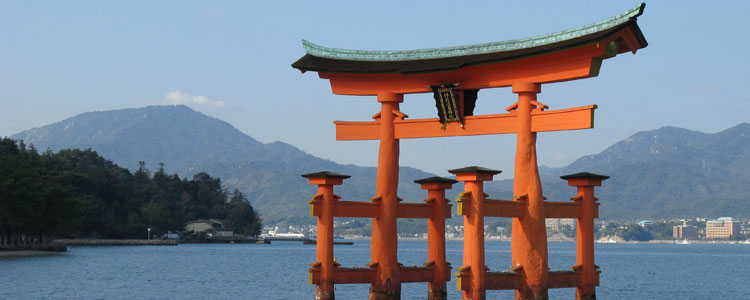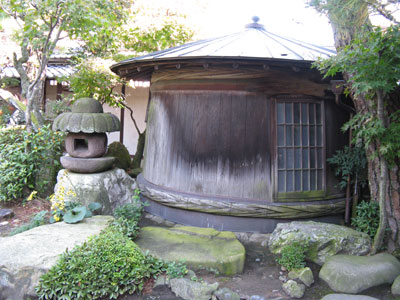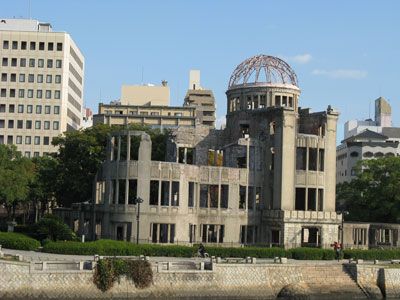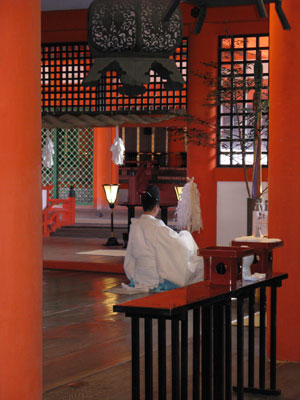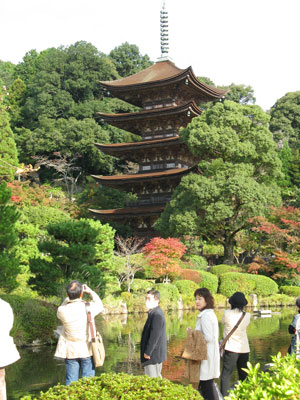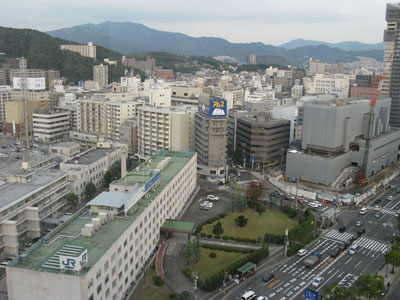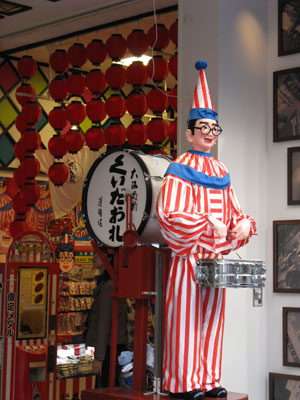From cities to the serene – touring Japan’s Honshu island
by Mary Beltran, ITN
Covering both the cities and rural areas of the southern end of Honshu island, my six-day, early-November ’09 tour of Japan, organized and sponsored by JTB USA, Inc., began and ended in Osaka. Throughout my journey, I was struck by both the unfailing politeness of everyone I met and the attention to detail displayed in so many aspects of Japanese life.
Starting out
I arrived in Osaka’s Kansai International Airport, which is conveniently located next to the Shin-Osaka transportation hub, where travelers can choose a bus, a taxi or even a ferry to get to their next destination. I was met by a JTB representative and by our English-speaking guide, “Mikey-san.”
JTB had booked seats for our small group of journalists and travel agents on the Japan Railways train to Osaka, from where we would continue by private bus to our hotel in Yuda Onsen. I joined some of the group members for a light dinner at one of the many small restaurants in the nearby shopping center while awaiting our train’s arrival.
On the JR express train our group had assigned seats in a smoking car, but we were able to move to the nonsmoking cars once we were under way. Each announcement of the few station stops the train made were preceded by a chime, followed by the name of the station, clearly audible, in both Japanese and English. Additionally, an electric sign at either end of the car displayed the name of the station in both languages.
Every 20 minutes or so a snack cart was wheeled through our car, followed by three young ladies with another cart picking up trash. Upon entering and leaving the car, they faced the passengers and bowed.
Since only snacks were for sale on the train, JTB provided bento box dinners for our group. There were 15 bite-size items, including pickled veggies, sticky rice, chicken nuggets, crab cakes and sweet bean confections.
Everything was tasty, and I enjoyed the details of the presentation — the shapes of the food, the variety of flavors and textures, the colorful desserts and even a tiny container of soy sauce shaped like a small fish.
Hot spring hotel
We ended our evening at Yuda Onsen, a popular vacation spot in Yamaguchi-city famous for its natural hot spring spas and baths (onsen). We stayed at Hotel New Tanaka, located in the middle of town on a street lined with both international chain hotels and traditional ryokan, all with onsen facilities.
The New Tanaka is a modern, Western-style hotel, and though my room was small, with a compact bathroom, it was well equipped. All the furniture was sized for more petite guests, so my 5’10” frame just barely fit on the single bed, but I did get a good night’s sleep.
Yamaguchi
The next day we toured Yamaguchi-city by coach and stopped for a guided tour of the Rurikoji five-storied pagoda, a national treasure. Located in Kozan Park, this carefully preserved pagoda is close to the city center but feels isolated because it’s tucked into a wooded valley on a hillside. We visited on a beautiful day, when the trees surrounding the temple and gardens were beginning to show their fall colors.
At the Yamaguchi Furusato Heritage Center (12 Shimotatekoji; phone 083 928 3333), after a short lesson on the history of lacquerware, the sensei, or master craftsman, walked us carefully through the steps of decorating a pair of chopsticks to which a base coat of lacquer had been applied.
We then were given some tiny diamonds of gold leaf and some gold-colored sprinkles to create our own designs. I promptly demonstrated the difficulty of the process by getting the wet lacquer on my hands and sticking the diamonds too firmly to the wood. After a gentle laugh, the sensei demonstrated the proper techniques again and my pair successfully joined the rest on the drying rack. The center later put the final sealing coat on my chopsticks and mailed them to my home.
The craft lesson costs about ¥800 ($9), and reservations should be made ahead. The center is open Monday through Saturday from 10 a.m. to 4 p.m.
Contemplative moments
After lunch we drove to Hofu to wander through the Lord Mohri Museum & Gardens (1-15-1 Tatara; phone 0835 22 0001), a reconstruction of a samurai-era nobleman’s house surrounded by traditional gardens. The original was the former residence of the Hagi feudal lord Mohri, and the interiors have been beautifully restored.
The museum houses an incredible scroll painting of the four seasons, another national treasure. Oddly, the museum doesn’t really promote this ink painting by Sesshu, so most of the visitors are Japanese tourists “in the know.”
We definitely needed our English-speaking guide, as the museum had only Japanese signage and brochures.
In the afternoon we drove to Suo-Oshima Island, located in the Inland Sea. The most beautiful place of my trip, it has orchards and small farms inland and seaside hotels and marinas along the water.
We stayed overnight at the Sunshine Sazan Seto Hotel & Resort, and I finally took the time to visit the hotel onsen. The hot spring waters relaxed my sore muscles from the day’s touring, which involved a great deal of walking up and down steps and quite a bit of standing while in the museums.
My suite faced the water, and the sound of the waves soothed me to sleep. In the morning I took an early walk along the seaside promenade, my only company an older gentleman practicing his golf shots along the grassy verge.
The Hawaii connection
That morning we took a short ride along a winding road lined with cherry trees — a popular drive during blossom time — and crossed a bridge to Okikamuro Island. This small island is said to have the oldest population in Japan, as mainly retirees live there (the oldest resident at the time of our visit was 100).
The island’s primary industry for centuries had been fishing, but as the fishing declined many people emigrated to Hawaii to look for better jobs.
An afternoon visit to the nearby Museum of Japanese Emigration to Hawaii (2144 Nishiyashiro, Suo-Oshima-cho, Oshima-Gun; phone 0820 74 4082) added more perspective to the close relations between the fishing villages of Yamaguchi Prefecture and Hawaii.
Thousands of people left to find jobs as contract laborers in the sugarcane plantations of Hawaii during the late 1800s and early 1900s, and the museum has a genealogical database where relatives of these government-contract emigrants can search for information about them. The database and information about the museum are available online.
Hiroshima
We spent the next two nights in Hiroshima at Hotel Granvia Hiroshima, a thoroughly Western-style hotel located right next to the main train station.
We had time to visit only two of the major sightseeing attractions in the area: Miyajima Island, where the Shinto Itsukushima Shrine is located, and Peace Memorial Park & Museum, in the city of Hiroshima.
A morning ferry ride took us to Miyajima Island and the Itsukushima Shrine, a UNESCO World Heritage Site. The shrine is famous for the beautiful, red torii (gate) that stands in the shallow water of the bay. When the tide is in, it appears to float above the water. The shrine is both a popular tourist attraction and a functioning Shinto temple. We saw a wedding party posing for pictures in front of the torii and a blessing ceremony for a five-year-old child.
Miyajima Island is also known for momiji manju, small, sweet, filled cakes shaped like maple leaves. On the way back to the ferry from the shrine, we strolled down a street lined with souvenir stands, restaurants and the many shops where the freshly baked, bite-size cakes were being sold hot out of the ovens or boxed to take home. We snapped up several boxes and munched on samples as we walked.
Back on the mainland for lunch, I had my first taste of the local speciality, okonomiyaki. At a local restaurant, I watched the complicated process of layering crepes with many ingredients to create the wondrous dish. The result was huge! Mine included chopped cabbage, thinly sliced pork, green onions, squid, shrimp, octopus, bean sprouts and more.
I tried and tried to work my way through but had to admit defeat after eating only half of one. A few in our group were able to finish their servings and were heartily applauded. Definitely give this dish a try if you are in Hiroshima!
My visit to the Peace Memorial Park & Museum (phone 81 82 242 7798) was intensely moving.
The memorial park was a welcome green space along the river in the middle of the huge, modern city. As I walked the paths, I could see over the trees to the Atomic Bomb Dome, a ruined building that is kept by the residents of Hiroshima as a symbol of both the horror of war and the hope for peace.
Inside, the exhibits in the first half of the museum covered the events leading up to the bombing. There are two amazing scale models showing the city before and after the bomb was dropped. The second half of the museum is filled with personal accounts and artifacts that brought home the human cost of these tragic events.
Osaka
Early the next morning we returned to Osaka, taking the train from the station just outside our hotel. We spent the day touring the city. My favorite stop was historic Osaka Castle (phone 06 6941 3044).
Although visiting the castle involved climbing many, many steps, which was hard on my knees, it was well worth it. The museum building and exhibits were fascinating and the view of the city from the top floor of the castle was breathtaking.
After a sushi lunch, we hit the streets for some serious shopping in the incredible Dotonbori shopping area.
Several blocks long and wide, the Dotonbori district is a popular place to hang out as well as shop. Huge department stores squeeze up close to tiny storefronts. Neon signs flash in garish displays, and store employees stand in the street urging passersby to come in and buy.
As we worked our way through the insanely crowded streets, we fortified ourselves with food from the cart vendors and munched our way from one end to the other, where our bus waited to take us to our final dinner together.
Summing up
I thought our itinerary was good, including historic and modern locations and varied activities. The time spent walking was well balanced with time to rest on the bus and breaks for eating.
The restaurants were excellent and the local food was diverse. However, if you don’t like seafood, you won’t be happy. Although there often were other options available, the primary foods on many menus were fish and shellfish, the quality of which was great because we were right on the coast.
The buffet breakfasts at our hotels always offered full Western selections as well as Japanese choices.
The accommodations, with the exception of my cozy room in Yuda Onsen, were roomy, and the hotels were conveniently located near shops and restaurants.
Prices are high in Japan and the dollar was not strong, so gift shopping was costly.
To do a similar trip independently would be very difficult. Though the rural areas are popular with Japanese travelers, they really are not set up to cater to foreign visitors yet. There were very few signs in English, and the museums usually did not have English-speaking guides available without prior arrangements.
At the hotels, usually at least one English speaker was at the front desk, but I had a hard time communicating with other staff members.
Most road signs were in Japanese, making a self-drive trip difficult (though the trains do run almost everywhere).
Of course, the big cities of Hiroshima and Osaka are quite used to foreign travelers, and everything at the major sightseeing locations there is readily accessible, with multilingual guides, audio tours and brochures.
The cost of a similar 6-day/5-night itinerary arranged with JTB is $5,990 per person for a group of two, including a guide, local transportation, accommodations, meals and entrance fees. The per-person price decreases with larger groups.
My most lingering memory of this trip is the amazing attention to detail and organization in many aspects of Japanese life — the tatami floor mats that were arranged in pleasing patterns, following specific design rules, rather than just being laid out straight; the restaurants that carefully timed courses so they arrived piping hot or chilled and crisp, and the customer service at the shops, where they carefully wrapped even the smallest item in gift paper and ended the transaction with a polite bow. This deep attention to the small pleasures of civility and beauty was evident everywhere I looked. ITN
Mary Beltran was a guest of JTB, with 18 US offices (800/685-5824 [Los Angeles]).

